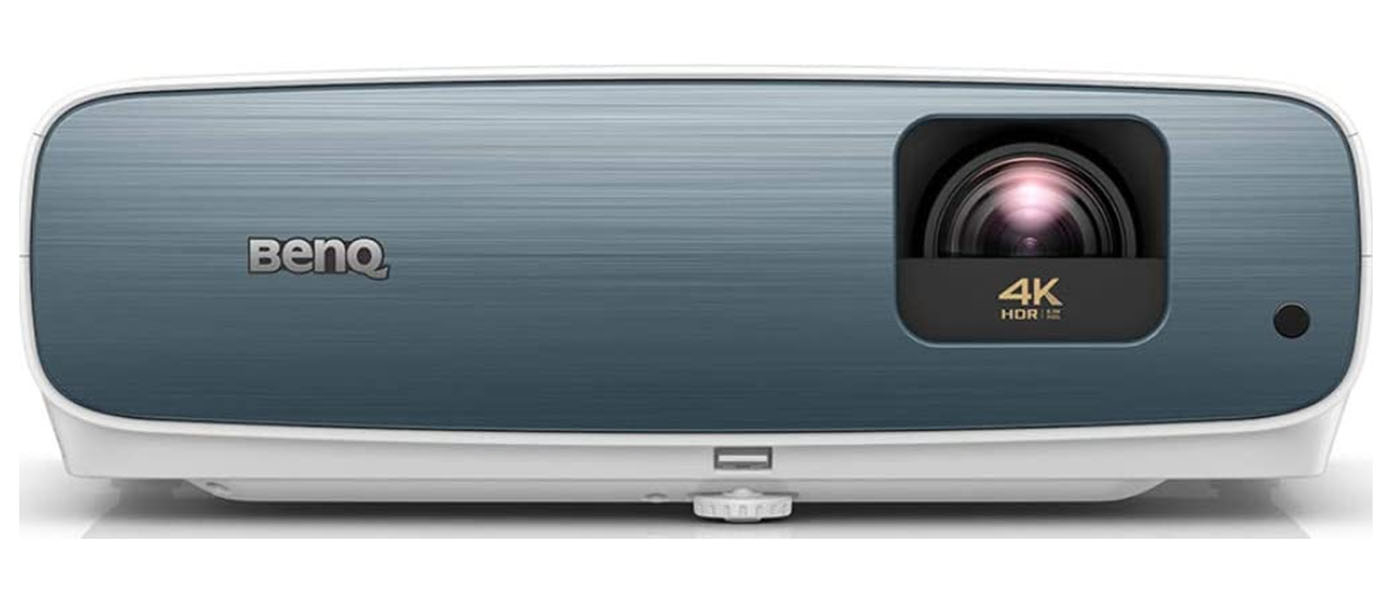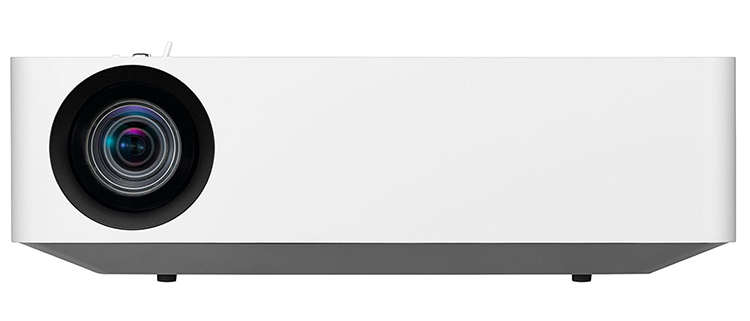
Most projector manufacturers have a display that can replace your television. But LG has taken it further than the competition with the HU70LAB. This diminutive box boasts in image up to 140 inches in size and offers full television functionality with a built-in tuner, speakers and streaming apps. It’s an Ultra HD DLP with extended color and HDR packed into a relatively tiny seven-pound chassis. With the included magic remote, you can navigate its menus by just waving the handset around and it even accepts voice commands for Amazon Alexa and Google Assistant. All this tech can be yours for less than $1800.
LG HU70LAB 4K UHD LED Projector
- Single-chip DLP with XPR technology for Ultra HD resolution and HDR
- Compact chassis that comes in white or black
- Four-channel LED light source eliminates the bulb and color wheel
- Built-in TV tuner plus streaming apps
Projector manufacturers have fought to stay relevant in today’s display market where you can get a 65-inch TV for less than $1000. Though front projection will always boast the biggest image, many consumers don’t want to give up the convenience of their TVs built-in audio, or the content delivery that comes with a DTV tuner and a network streaming interface.
LG has leveraged its TV tech by rolling all these features into a compact DLP projector, the HU70LAB. Weighing in it just over seven pounds it packs a single-chip DLP light engine with XPR technology that takes resolution to Ultra HD, 3840×2160. You also decent coverage of the DCI-P3 color gamut and HDR10. The light source is four-channel LED so there’s no color wheel and no bulb to replace. The claimed lifespan is a generous 30,000 hours. Built-in speakers provide decent audio quality and HDMI 2.0 inputs ensure compatibility with the newest source components. And there’s something I’ve never seen before on a projector – a coax antenna input for an internal DTV tuner. It looks like a seriously cool display packed into a seven-pound chassis that comes in white or black. Let’s take a look.
Type:
.47” single-chip DLP
Native resolution:
1920×1080, 3840×2160 w/XPR pixel-shift, 16:9 aspect ratio
Color gamut:
DCI-P3
HDR:
HDR10
3D:
No
Throw ratio:
1.22-1.53:1
Lens shift:
No
Light source:
4-channel LED
Light output (mfr):
1500 ANSI lumens
Lamp service life:
30,000 hours
Video connections:
2x HDMI 2.0, USB-C, coax (DTV tuner)
Additional connections:
2x USB 2.0, RJ-45, 3.5mm audio out
Speakers:
2x 3 watts
Dimensions:
12.4” x 3.7” x 8.3” (WxHxD)
Weight:
7.1lbs
Warranty:
1 year
LG HU70LAB 4K UHD LED Projector Price:
$1799
Website:
Company:
SECRETS Tags:
LG, HU70LAB, 4K, Ultra HD Projector, DLP Projector, HDR, Ultra HD, XPR, LED, Projector Review 2020
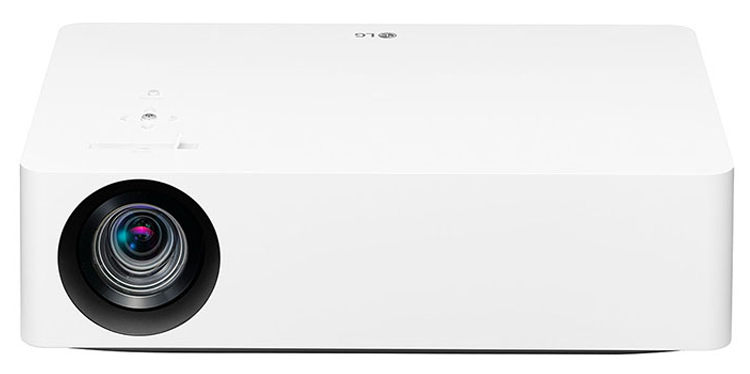
By now, most users know that Ultra HD DLP chips come in two flavors. One is .66” in size with a native resolution of 2716×1528 pixels. The other is .47” with a 1920×1080 pixel count. The HU70LAB uses the latter along with XPR technology, a form of pixel shift, to achieve 3840×2160 addressable pixels. Visually, the difference between either chip or a native 4K projector is small, especially at screen sizes less than 150 inches. I’ve seen a good number of both variants and they compare favorably to native 4K projectors like JVC’s ultra-expensive RS4500.
LG dispenses with the UHP lamp in favor of a four-channel LED light source. Obviously, this means a lot of good things like less heat, a longer life span and no color wheel. Fan noise is almost non-existent and when you shut the HU70LAB down, there’s no cooling cycle. There are also no large light-leaking vents to deal with. Not a single electron escapes the tiny chassis. The projector is rated for 30,000 hours of operation which is long enough to last through several generations of display tech.
The LED array uses four elements, the three primary colors plus a fourth that combines a blue pump and a g-refiner that combine to create a dynamic green; those are LG’s terms, not mine. The result is 77% coverage of DCI-P3, not as much as some flat panels but as much as many projectors that include extended color gamuts. In practice, the HU70LAB’s green primary is slightly more saturated than Rec.709 while red and blue are significantly more so. Visually, the color quality and image sharpness are excellent. The XPR module provides Ultra HD resolution that definitely improves upon Full HD up to its maximum size of 140 inches diagonal.
The lens is offset to one side and features a 1.25x zoom adjustment with a motorized focus control. There is no shift available, so you’ll have to place the HU70LAB a bit above the bottom of your screen. LG doesn’t specify the offset value but, in my application, it looks like around 95%. Light output is a claimed 1500 lumens which means you’ll want a small room with little to no ambient light. I managed to coax just under 100 nits from it after calibration with 134 nits available in the brightest picture mode.
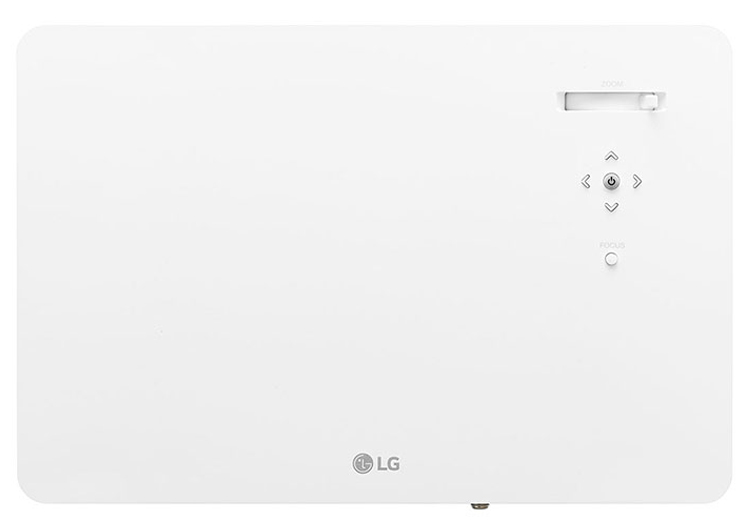
The feature list is a long one. Besides Ultra HD resolution, HDR and extended color, you get a DTV tuner and a network interface with LG’s streaming interface, ThinQ AI webOS to be exact. The network connection is via RJ-45 or Wi-Fi, or you can hook up an OTA antenna or cable drop for the internal tuner. A pair of three-watt speakers complete the package making the HU70LAB a full-fledged television.

The backlit (yay!) remote is LG’s Magic Remote which accepts voice commands through Amazon Alexa or Google Assistant and wirelessly controls an on-screen cursor. Once paired, pressing any button brings up a comprehensive menu. Tweakers will delight in the calibration controls which include color management and 2, 11 or 22-point white balance sliders. You also get gamma presets, frame interpolation, anti-judder, dynamic contrast and dynamic tone mapping for HDR. Gamers will want to engage the low-lag mode for quicker control response.

The HU70LAB’s back panel looks spartan but everything you need is there. Two HDMI 2.0 inputs provide the necessary bandwidth for HDR and 10-bit color. HDMI 1 also features Audio Return Channel (ARC). A USB-C port accepts video signals as well. The DTV tuner is fed by a threaded coax fitting. Networking comes through either RJ-45 or the built-in Wi-Fi which I used to connect to my wireless access point. There are two audio outputs as well, a 3.5mm analog and a S/PDIF optical port. Two USB ports provide data input and can accept wireless dongles for things like keyboards and mice. Speaking of plugging in, the projector’s power supply is external and comes in the form of a small brick. You’ll need to find a place for it if you decide to mount on the ceiling.
After telling the network setup my location, it offered to scan cable channels. Since I had no appropriate connection for that, I declined. Pressing the home button on the remote brings up LG’s webOS interface which looks the same as what I saw when I reviewed the HU85LA UST projector. It has apps for all the major services and the remote features instant-access buttons for Amazon Prime and Netflix. I also hooked up a signal generator to the HDMI 1 input and later, an OPPO UDP-203 for the viewing tests.
Secrets Sponsor
The menu system is also the same as other LG products with everything necessary for a full calibration. For SDR signals, there are two Expert modes, Dark and Bright, that offer color management and white balance adjustments. I used the Bright mode and achieved excellent accuracy though I couldn’t quite dial the color gamut down to a perfect Rec.709. Though I set the option to Auto, the HU70LAB still renders all material with its native gamut. Greens are to spec but blue and red are a bit over-saturated when watching SDR and standard Blu-rays.
HDR opens up five more picture modes of which Cinema is the closest to correct. You can perform a full calibration for HDR signals and again, I achieved excellent accuracy with a nearly perfect grayscale, a spot-on EOTF curve and good saturation tracking of the DCI-P3 gamut. You can see all my results in the Benchmark section of this review.
But enough geek talk, let’s watch some movies!
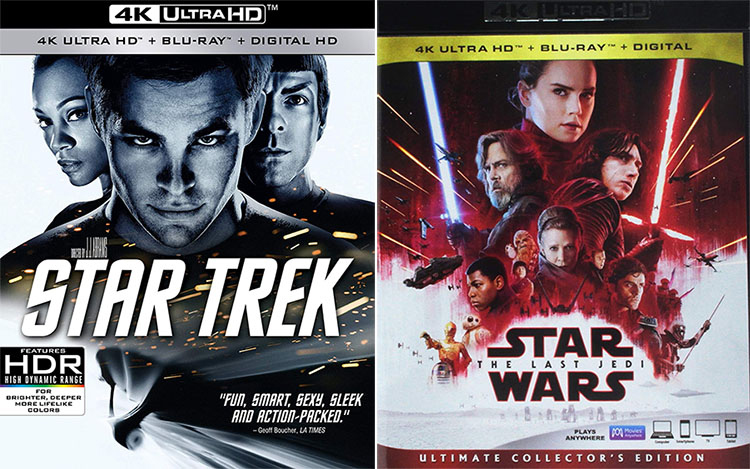
My overall impressions of the HU70LAB’s image were that it was very sharp, as all 4K DLPs seem to be, and very colorful, especially in red hues. XPR technology is quite effective at producing an Ultra HD picture from a 1920×1080 pixel chip and I defy anyone to tell the difference between it and a native 4K projector. There are no visible pixel gaps on my 92-inch screen and no artifacts from the shifting process. Detail is fine from corner to corner and I saw no lens aberrations.
In J.J. Abrams Star Trek, I focused on a scene at Starfleet Academy where cadets are bustling about outside wearing bright red uniforms. This hue is a real testament to the DCI-P3 gamut’s extra red. You won’t see this shade from a Full HD projector with its less-saturated primaries. Bright material in this film pops nicely with plenty of detail and no clipping that I could see.
Experimenting with the different dynamic contrast settings, I finally decided on high, the most aggressive. It seemed to have no downside as all detail was fully rendered in both highlight and shadow areas. I paused several times to check out dark material and at no time did I see clipping. It’s also important to turn dynamic tone mapping on. This feature analyzes the content frame-by-frame to match the projector’s output exactly with the incoming signal’s dynamic range. This is something that all projectors should have to compensate for their relatively low native contrast.
Black levels were reasonable for a compact DLP, but you won’t see the inkiest shades from the HU70LAB unless some bright highlights are present. It only takes a few small bits to make the rest of the image look satisfyingly dark.
Moving on to Star Wars, The Last Jedi, I was once again impressed by the deep and vibrant red of the salt on the ground in front of the rebel base. Color like this is the real reason to make the jump to Ultra HD. Fast motion stayed sharp too, thanks to the HU70LAB’s excellent motion processing.
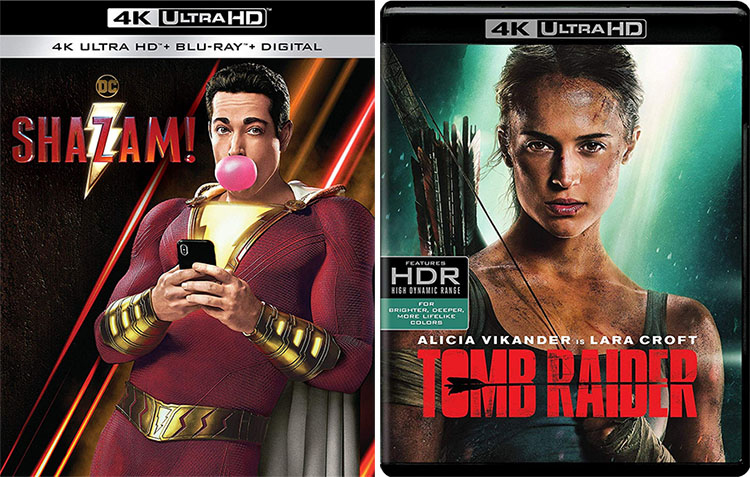
The carnival scene near the of Shazam! is a great test of contrast. The lights of the midway and the rides pop brightly against the nighttime backdrop. It’s a shame the HU70LAB doesn’t support Dolby Vision but its HDR10 processing did a fine job with this film. Blacks are nice and deep thanks to the super-bright highlights which are all over this part of the movie. The red of Shazam’s suit is not only super-saturated, but you can also see its fine texture with ease.
My final viewing was of Tomb Raider with Alicia Vikander as Lara Croft. The final act takes place underground in a tomb of course, with only dim lighting from flashlights and torches. Here, things looked a bit gray as there were no specular elements to offset the background. This is DLP’s one weakness and the HU70LAB is no worse or better than any other DLP in this regard. Detail still shone through and I enjoyed the movie as much as ever.

I spent a few minutes exploring the LG webOS streaming apps, then set myself up for a few episodes of The Grand Tour on Amazon Prime. You can get right to that service from a dedicated remote key. Though the signal was 1080p, it still looked razor-sharp with smooth camera pans and solid motion resolution. Only the occasional judder artifact revealed the content’s compression level. For most scenes, it looked every bit as good as a Blu-ray.
I watched the show using the HU70LAB’s built-in speakers and was pleasantly surprised by their sound quality. Even with the volume maxed, there was no distortion and the frequency range was wider than one might expect from tiny transducers driven by three-watt op-amps. I would rate them as good as the best speakers built into a flat panel; definitely well above average. If you’d rather use external audio, there is a 3.5mm analog jack along with an optical port. The best option though is to use HDMI 1 which has ARC.
For SDR content, the best image fidelity is found in the two Expert modes. I chose Bright which delivered around 100 nits in my completely dark theater. Dark takes that down to around 80 nits. By default, all image enhancements are turned off, as they should be.
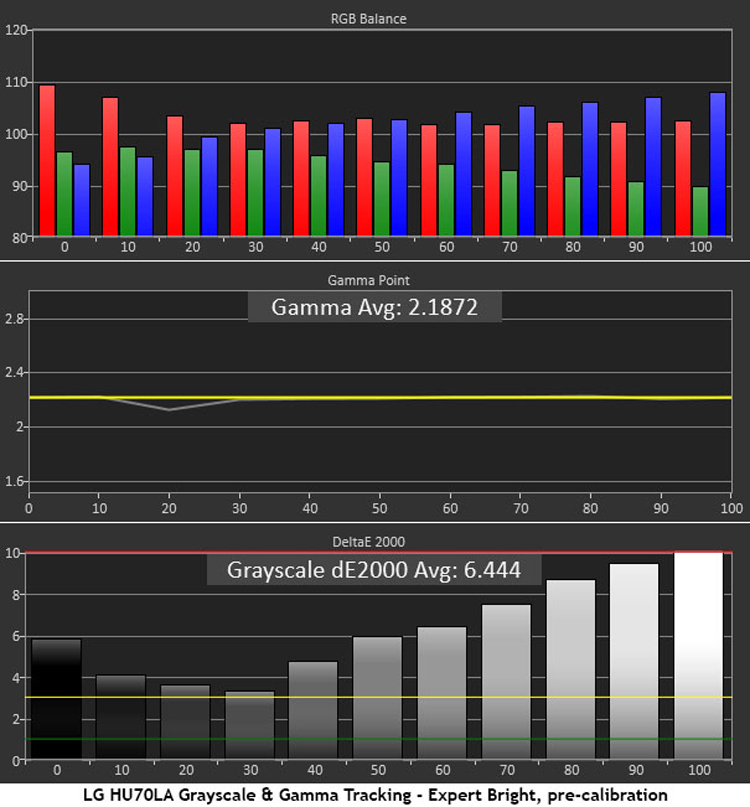
Straight out of the box, the Expert mode’s medium color temp looks a tad purple in the mid-tones and highlight areas of the image. The darkest steps show a bit of warmth as well. Gamma is nearly perfect with just the slightest aberration at 10%. I was unable to see this error with the naked eye. Though the grayscale error is a bit higher than average for this price category, the gamma tracking tells me I’ll have little trouble dialing the HU70LAB in.
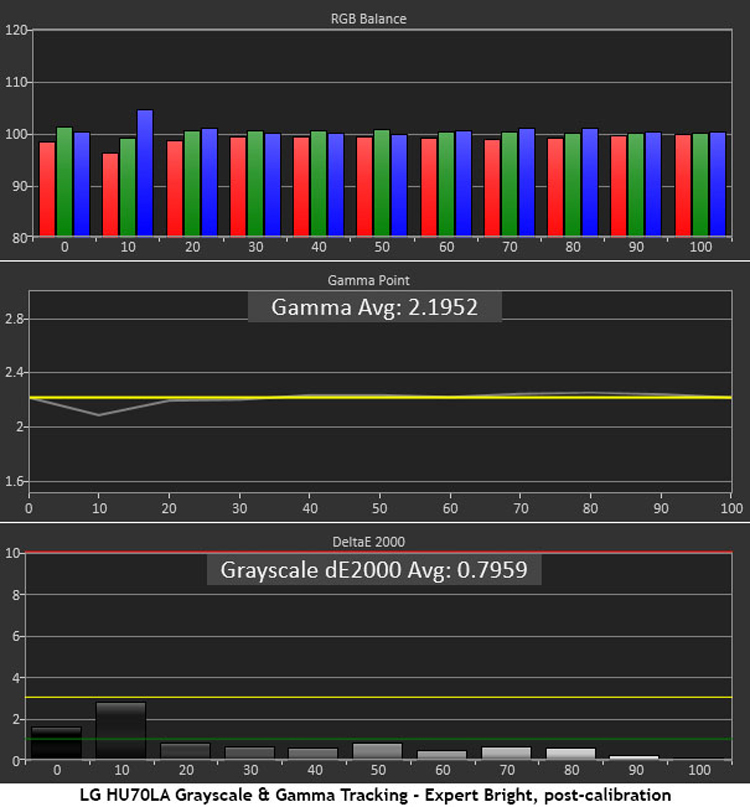
I only needed the two-point white balance option to achieve superb grayscale accuracy. There are no visible errors here and all but zero and 10% are below the 1dE threshold. It doesn’t get much better than this, especially for just $1800. Gamma remains near-perfect as well after calibration.
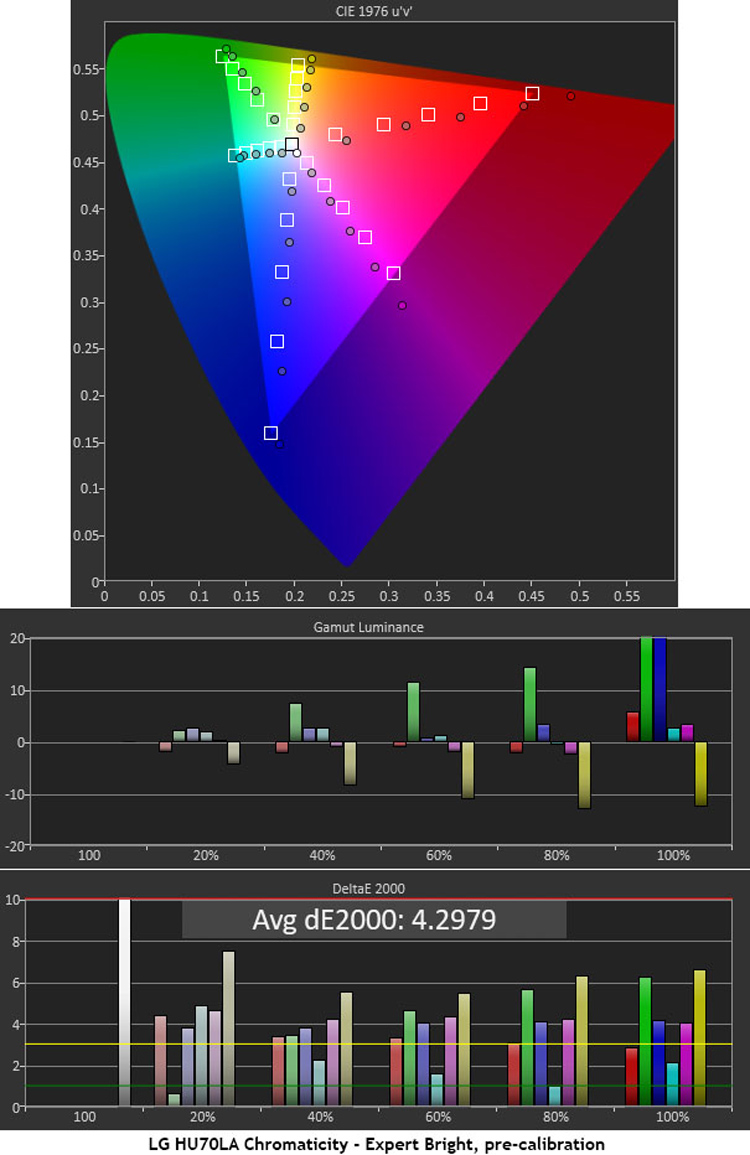
The HU70LAB’s out-of-box color measurement shows the over-saturation in red and blue I spoke of earlier. The projector runs in its native gamut for both SDR and HDR content. The menu options are just Auto or Extended. I thought Auto would switch between Rec.709 and DCI but that was not the case. Yellow and magenta are slightly off-hue as well. The image looks good in practice with vivid color and solid detail. Even without adjustment, it never looks over-blown or harsh.

I attempted to create an accurate Rec.709 gamut using the color management system. While I was able to get the 100% saturation points on-target, it de-saturated the inner points too much. I finally adjusted using 40% patterns to get the above result. I’d call it a little less over-saturated and real-world content looks more natural. Calibration definitely brings a positive impact. While I would prefer to see a Rec.709 gamut option, the HU70LAB looks pretty good.
To simulate an HDR10 signal, I added an HD Fury Integral to the signal path. It creates the proper tone map to allow HDR measurements using CalMAN’s special workflow. These tests, and the HDR calibration, were performed in the HU70LAB’s Cinema picture mode.

When an HDR signal is detected, the HU70LAB automatically switches modes and offers five new picture presets. Cinema is the best choice as it delivers a reasonably accurate EOTF luminance curve although grayscale runs too blue. White balance controls are independent for HDR, so I had little trouble using the two-point sliders again to make some nice gains.
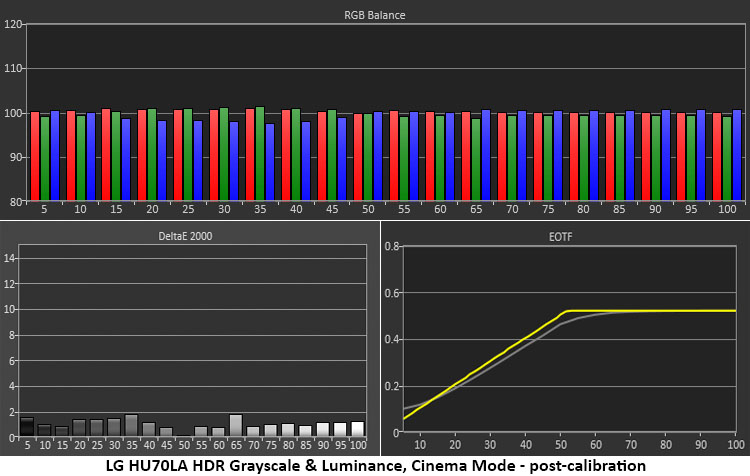
After a few tweaks, grayscale is essentially perfect with all errors below 2dE. The EOTF curve remains unchanged. This is excellent performance.
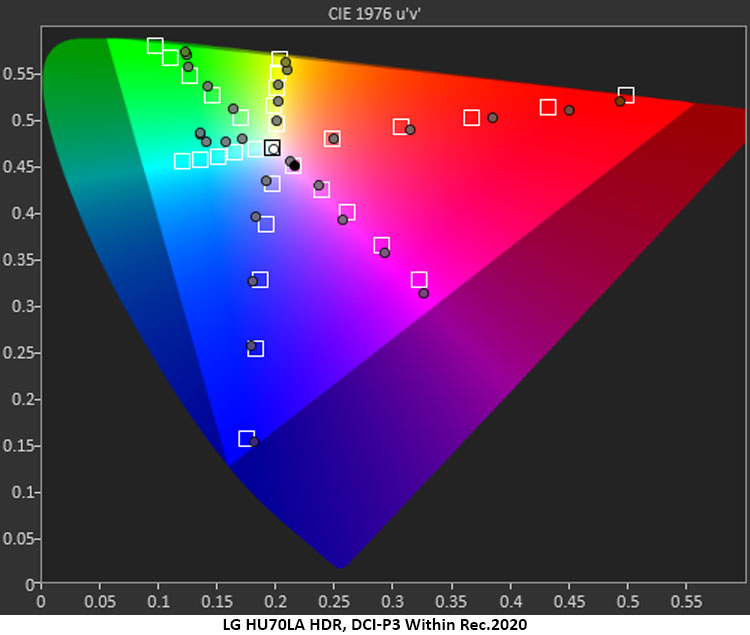
The HU70LAB tracks the DCI-P3 gamut well in yellow, red, magenta and blue. Green and cyan come up a bit short of the full saturation and they are slightly off-hue as well. I tried both the Auto and Extended settings for gamut and settled on the latter as the best choice. Both options measure nearly the same but Extended provides slightly more luminance.

The HU70LAB earns a perfect 100% score in my suite of video processing tests. Even the difficult 2:2 clip merits a passing grade. If anyone wonders why these tests are still relevant, it should be noted that streamed content is all over the map when it comes to signal format and frame cadence. You can literally be switching between 4:4:4, 4:2:2 and 4:2:0 from the same provider. And there’s no telling whether film-mode cadences have been edited correctly. Displays need good video processing today more than they ever have and the HU70LAB delivers.
All luminance values are expressed here in nits, also known as candelas per square meter (cd/m2). For those needing a frame of reference, 1fL equals 3.43 nits, or 1 nit equals .29fL.
The HU70LAB’s output is appropriate for a small room with light control. Some ambient light is OK but total darkness will ensure the best possible image. After calibration of the Expert Bright mode, I measured 97.257 nits peak, .2410 nit black and 405.1:1 contrast.
The dynamic contrast control has three levels; low, medium and high. None of them made a difference when I measured static patterns, but they have a significant impact on actual content. I found I could run the highest setting with no clipping and still get a very satisfying image. It appears that it works on a frame-by-frame basis. Systems like this won’t do their thing with static field patterns, only in content with its constantly varying levels.
Secrets Sponsor
There is no traditional bulb power control but there is a power-saving option that dims the LEDs in three steps. Since fan noise is minimal, I saw no reason not to run the brightest option.
In HDR mode, the peak white was 110.9861 nits, black was .2395 nit and contrast was 463.5:1. Again, this is not a fair assessment of the HU70LAB’s HDR performance because dynamic contrast only works with normal content. It won’t improve the measurements of static patterns.
For max output, there is a Vivid mode that provides 134.2685 nits peak, .2396 nit black and 560.4:1 contrast. Though the ratio is higher than the calibrated and HDR values, it is at the expense of some detail loss in highlight and shadow areas. Vivid also features a very cool grayscale.
SDR
- Expert Bright
- Contrast 85
- Brightness 50
- Sharpness 5
- Color 50
- Tint 0
- Color Temp Medium
- Dynamic Contrast High
- Color Gamut Auto
- Gamma 2.2
White Balance -Two Point
- Rh -2
- Gh 15
- Bh -14
- Rl -7
- Gl -2
- Bl 8
Color Management
| Sat | Tnt | Lum | |
| R | -2 | 0 | 3 |
| G | 0 | 0 | 0 |
| B | 0 | 0 | 0 |
| C | 0 | 6 | 0 |
| M | 0 | 0 | 0 |
| Y | 0 | 5 | 4 |
HDR
- Mode Digital Cinema
- Dynamic Tone Mapping On
- Dynamic Contrast High
- Color Gamut Extended
White Balance – Two Point
- Rh 0
- Gh 11
- Bh -23

The LG HU70LAB offers full television functionality for less than the price of a premium 65” flat panel. At $1800, it’s a great value projector and all-around display.
- Vibrant color
- Sharp image
- Convenient streaming and connection options
- More contrast
I really enjoyed my time with the LG HU70LAB. I’ve been more and more impressed with each new compact DLP projector that comes down the pike. While pickier videophiles may say nothing beats a native 4K projector, I have seen no proof of that. Yes, the JVC RS4500 looks great but much of that is due to its premium lens. For a fraction of the price, you can have something like this LG that puts a fantastically sharp picture on the screen with good dynamic range, saturated color, and solid video processing.
That LG has included full television functionality in the HU70LAB is a great bonus. No other projector offers a true TV experience with a refined streaming interface and a DTV tuner. Yes, you’ll spend around $2000 by the time you purchase a decent screen. And you won’t be able to watch it in your sunlit living room. But if you can manage the installation, this projector can easily become your main display. It delivers cable channels, streaming carriers and a stunning image with Ultra HD resolution, HDR and extended color, all from a tiny box that leaks no light and barely makes a sound. And its LED light source promises 30,000 hours of maintenance-free entertainment. What’s not to like? I give the LG HU70LAB Projector my highest recommendation.


